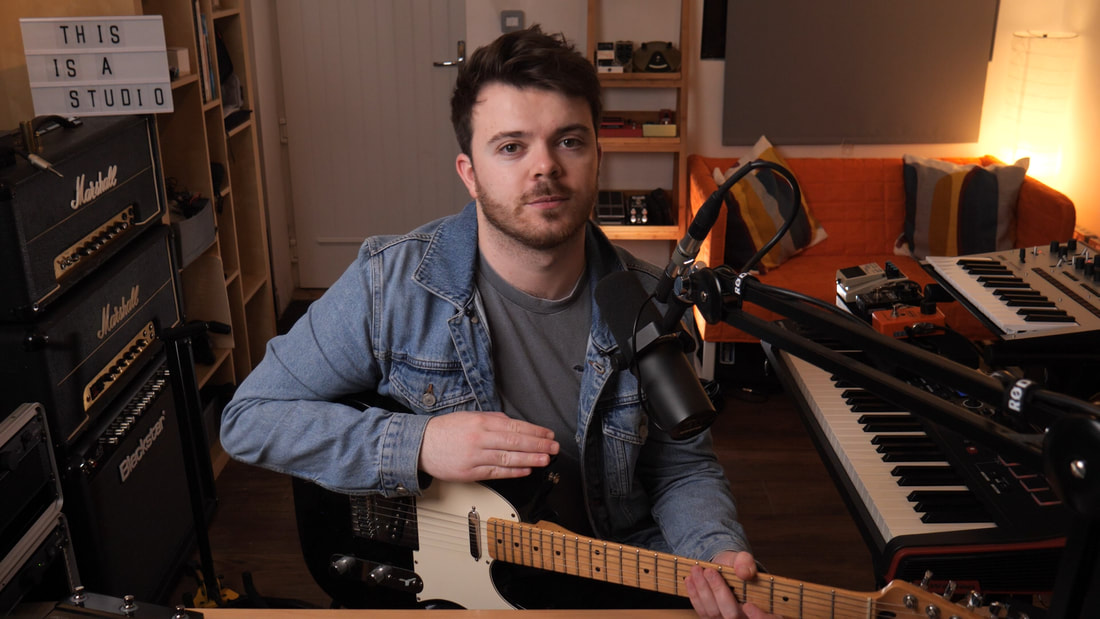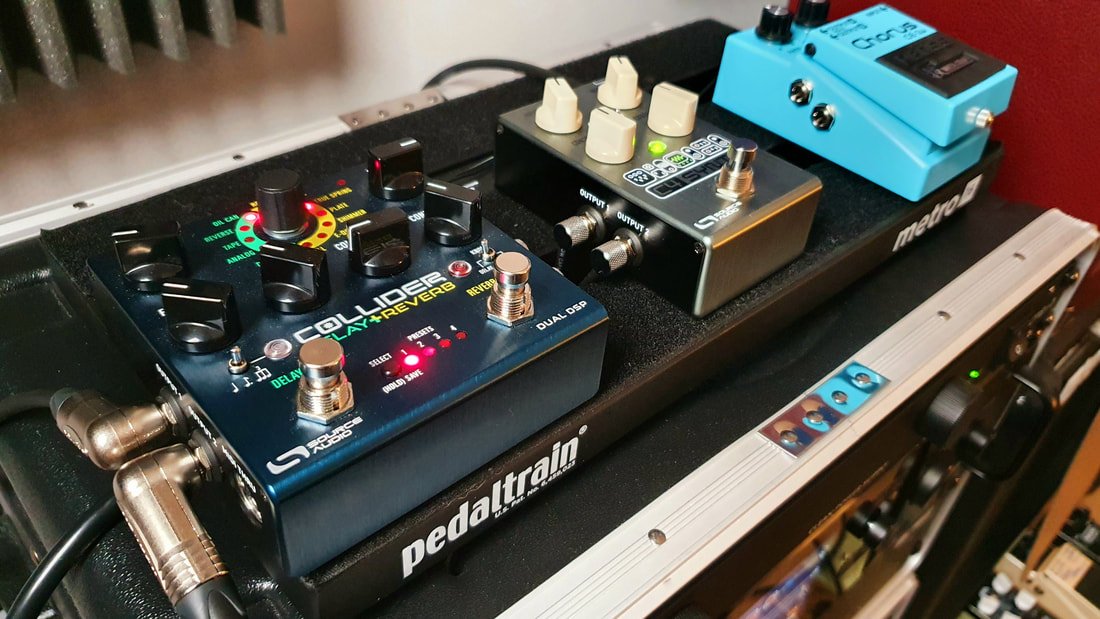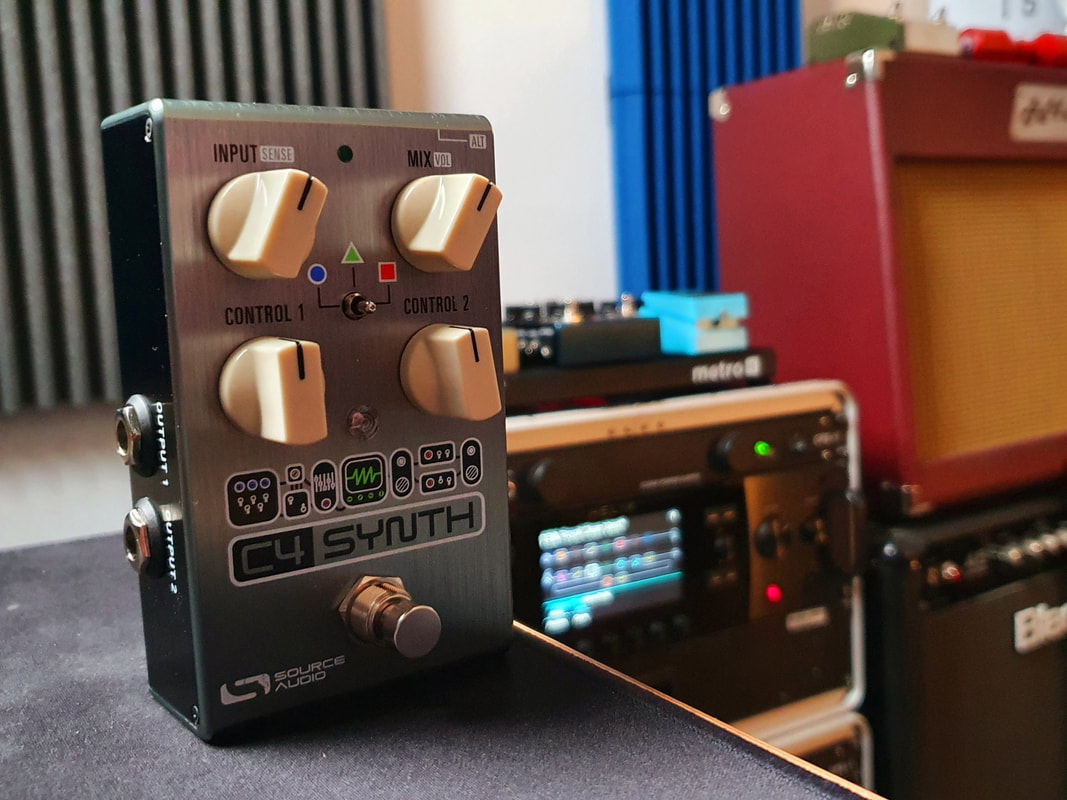|
Happy Spring, everyone! It has been a little too long since our last Neuro Artist Feature. We apologize for the delay, we've been so tied up with the release of the Ultrawave Multiband Processor and Ultrawave Multiband Bass Processor pedals that we had to hit the pause button for a month or two. But the Featured Artist program is back... with STYLE! Sean Murray is a hugely talented musician out of Cork, Ireland. We had not heard his music prior to the day he posted an exceptional demo of the Collider Delay+Reverb back in September of 2020. We were blown away, not only by Sean's excellent tone and guitar playing, he also has a wonderful knack for explaining with crystal clarity the type of sound he wants to achieve, why he thinks it's a useful sound, and how he goes about finding that sound with his Source Audio gear. Sean quickly followed up his Collider demo with a tremendous C4 Synth video. Each video was accompanied with five excellent Neuro presets, and each is available for free download right now via the Neuro App and Desktop Editor. We also recommend subscribing to Sean's Youtube channel. His tutorial videos are an outstanding resource for anybody looking to improve their home recording techniques. The channel's audience is growing fast and for good reason - Sean is consistently posting excellent new videos all the time. Of course, all of our Featured Neuro Artists get free Source Audio pedals. If you want to learn more about our Neuro Artist Program, follow this link. We're always looking for new artists on which to shine our spotlight. Sean chose for his free pedal, a Ventris Dual Reverb, and lucky for us he also found the time to post a great demo video and publish some excellent presets. One of the things we love most about Sean's approach to demo videos is his emphasis on the essential, real-world applications for each effect. In the following three videos Sean walks us through all of his presets. In each video you will find great ideas on using Source Audio pedals to capture classic tones as well as explore some exciting, new sonic territory. The Collider Delay+Reverb Presets:"Sean Murray Country Slap" - Collider Delay+ReverbSean's "Country Slap" preset is a fantastic sound that works in all kinds of situations. Clearly it sounds great in a country setting, but slapback delay can also do wonders to an overdriven lead tone. Sean explained the preset: "I'm using the Analog Delay algorithm. It's set up for a really simple slap-back style delay. The tone is turned down to darken the repeats and I've got absolutely no modulation. On the reverb side, I'm using the True Spring Reverb for some really nice spring reverb tones." (Clip starts at 1:00 in the video) "Sean Murray Tape/Mod Verb" - Collider Delay+ReverbThis preset offers some beautiful ambient tones from the Collider. Sean explains, "I'm using the Tape Delay algorithm and I've got some modulation dialed in. I have the Collider connected via USB to my computer, so the delay time is synced up via MIDI Clock, which is cool. For the reverb I've got the E-Dome algorithm dialed in for a really nice lush, atmospheric reverb." (Clip starts at 1:35) "Sean Murray Lush Swells" - Collider Delay+ReverbFor the "Lush Swells" preset Sean delves into the Collider's "Unlock" feature, which offers the ability to run either two reverbs or two delays at the same time. It also makes it possible to switch the order of effects and put a reverb in front of a delay in the signal chain. In this preset, to create some beautiful ambient chord pads, Sean runs the Swell engine in front of the E-Dome engine for nice slow and soft attack followed by huge, lingering reverb with just a touch of modulation. The very end of the clip features the Collider's Hold (or "Freeze") feature, which allows you to sustain a reverb tail by simply holding down the right footswitch. (Clip starts at 2:21) "Sean Murray 80's Chorus/Verb" - Collider Delay+ReverbThe Collider has a few tricks hidden up its sleeve, and this is a great one. Sean explains, "This isn't actually a delay effect at all, it's a chorus. I'm using the Analog algorithm on the delay side and by turning the Delay and the Feedback dials down, and adding some modulation, you can dial in some pretty cool chorus tones. For the reverb I'm using the E-Dome. I've dialed in a preset on my HX Stomp with a pre-amp, some compression, and no cabinet impulse response, so you get instant DI (Direct Input), 80s guitar tones." (Clip starts at 3:20) "Sean Murray LoFi Tape" - Collider Delay+ReverbAgain we follow the road-less-taken, with very cool lo-fi effect. Sean explains, "The 80's Chorus/Verb preset got me thinking, 'what else can I do with it that isn't just your traditional delay or reverb.' So using the Tape algorithm, I tried to dial in an out-of-tune, lo-fi, warble tape sound. Again I've got the Delay Time all the way down, Feedback pretty low, Mix all the way up so we're just hearing the affected signal, and I've dialed in a lot of modulation depth, but with a really slow rate. I've also got the Tone control turned down to darken the overall signal. And for reverb I'm using the True Spring algorithm." (Clip starts at 4:23) The C4 Synth Presets:"Sean Murray - Mono LoFi Chorus" - C4 SynthSean loves his lo-fi sounds, and this is a great one for the C4. He describes, "this preset was designed to emulate a cool tape/pitch warble effect. It uses one of the “Polyphonic Pitch” voices, which allows your dry guitar signal to be manipulated and further processed through the distortion and filter sections of the C4 Synth. I’m using the LFO set to a Sample & Hold (random) wave shape, to modulate both the pitch and volume of the processed guitar signal, which creates a convincing tape warble and scratchy, audio dropout effect! Routing this signal through the Sample Reducer and Bandpass Filter further adds to the Lo-fi effect. Control 2 on the pedal is assigned to the volume of Voice 2 which adds a higher octave to the wet signal for a more interesting result. Because a small bit of latency is added to the Polyphonic Pitch voices (to allow the signal to be processed), dialing back the DRY/WET mix to blend in your unprocessed dry signal creates an interesting and unique Chorus, using the modulated, tape warble as the wet signal." (Clip starts at 0:24). "Sean Murray - Stereo Riffage" - C4 SynthThis one is a super-thick and super-nasty riff machine! Sean describes the preset, "The tracking on the C4 Synth is incredibly fast and accurate. For this preset, I dialed in a massive monosynth for heavy riffs and bass lines. When producing, I love blending synths with guitar and bass lines to add some texture and a more synthetic vibe to an otherwise simple guitar tone. Because I’m utilizing the Stereo L/R outputs of the C4 synth and panning the synth’s oscillators for stereo width, I have the DRY/WET mix set to 100% and I’m blending the C4 in with my dry guitar signal via an external mixer, but in a more traditional setup, dialing back the DRY/WET mix on the pedal itself is a great way to add some synth textures to your dry tone." (Clip starts at 4:14) "Sean Murray - Mono Dirty Filter" - C4 SynthThis preset steps away from the pure synth oscillators and focuses on the power of the C4's Filter module to achieve a great envelope filter effect. Sean explains, "What I love most about the customizable routing of the C4 Synth, is that it’s possible to route your dry signal through the Distortion and Filter sections and use it as an Envelope Filter or a straight up Overdrive/Distortion pedal! With the various distortion and filter types, there are so many creative possibilities, but for this preset I dialed in a simple Low Pass Envelope Filter with a healthy amount of Saturation dialed in via the Distortion section. Control 1 adjusts the Filter Frequency and Control 2 dials in the depth of the filter envelope." (Clip starts at 6:26) "Sean Murray - Stereo Bass Funk" - C4 SynthTurn that guitar into a bass! Or turn your bass into an even better bass with this great synth bass sound. Sean explains, "This preset emulates a vintage, mono synth bass but with a modern twist. The pitch detection of this preset is set up for standard tuning on an electric guitar, but can easily be tailored for bass guitars or other instruments by adjusting the octaves of the Voices. Voices 2 and 3 are set as Saw waves and are slightly detuned to add some depth. I’ve panned these left and right for stereo width and added Voice 4 (panned in the center) for a square wave blend. These voices are run through some saturation and a snappy envelope controlled Low Pass Filter, but I’ve also added a clean, Sine wave sub via Voice 1, which is routed directly to the output to ensure the sub bass is clean and unaffected by the drive and filter. This preset is perfect for snappy, 80’s style bass lines! Control 1 adjusts the Filter Frequency and Control 2 dials in the speed of the decay of the Filter Envelope, allowing you to adjust the overall snap." (Clip starts at 8:35) "Sean Murray - D&B Swell" - C4 SynthThis is a great modern bass sound. Sean gives us a great description of what Reese Bass is and how to achieve it with the C4, "If you’re as big a fan of Drum and Bass as me, you’ll know the infamous sound of the Reese Bass! I’ve dialed in 2 square waves using Voices 1 and 2 and detuned them heavily for that typical Reese Bass pitch movement. The LFO is modulating the tremolo of these voices to add some additional movement. Voices 3 and 4 provide a sub octave and 5th that are again routed to the main outputs for a solid and clean sub bass. The envelope controls the Filter Cutoff and is set to a slow swell, but because the Square wave Voices are the only oscillators routed to the filter, the sub is always audible and the brightness of the square waves only swells in on sustained notes as the filter frequency opens up!" (Clip starts at 10:41) The Ventris Dual Reverb Presets:"Sean Murray - Perfect Room" - Ventris Dual ReverbSound scientists all over the world are still searching for the perfect room. Is it possible the Sean has already found it? He introduces this video by saying, "Today we're going to take a look at four really simple, but really, really useful reverb tones. His Perfect Room preset is a great example of "very useful" sound. He explains, "You can hear I've got a lot of Pre-Delay dialed in - there's a tiny bit of delay between when I hit the guitar and when the reverb starts. What this is really good for is separating your pick attack from the room reverb. If you have the Pre-Delay set too low, the reverb blends in a little bit too much with your guitar tone and sounds a little mushy." The Pre-Delay is also a great way to really create a sense of space within a reverb. It nicely mimics the sound of your amplified guitar bouncing off the surrounding walls. (Clip starts at 1:07) "Sean Murray - Dark Spring" - Ventris Dual ReverbImagine if the spring reverb on your amplifier had more than just a single control. With his "Dark Spring" preset, Sean explores the possibilities of taking a traditional spring reverb sound and chiseling it to perfectly fit his needs and taste. He explains, "What's really great about the True Spring sound on the Ventris is that is has that typical 'drip' sound that you hear in a lot of spring tanks. When I really dig into the strings you can really hear that splash and that spring tank rattle. The tone is very much a part of the guitar sound - it's a very lo-fi. When, I'm dialing a spring reverb it's for some mono depth or it's for more of a character part." (Clip starts at 3:29) "Sean Murray - Mod Club" - Ventris Dual ReverbWithin many of the Ventris' reverb engines there is a sub-collection of alternate Size options. Sean's "Mod Club" preset uses a sub-option from the Room engine called "Club." Club is a slightly larger Room sound. "I've got the Input Low Cut dialed in all the way so it's filtering out pretty much all of the low-end going into the reverb. I also have the reverb's treble control turned up quite a bit, which shapes the reverb to sit on top of the guitar tone a little bit more. I've also got the modulation depth turn up with a slow rate to achieve a nice, lush modulation over a long period of time. This type of reverb is a little bit cheesy, a little bit overused, but I find that in the right moment of the right song, in the right production, it can be the perfect thing to add to your guitar." (Clip starts at 5:54). "Sean Murray - Memory DLY" - Ventris Dual ReverbOf course the focus of the Ventris is great reverb sounds, but the Echoverb engine acts as a great stand-in for a delay pedal. Sean dialed a really great sounding delay sound with his "Memory DLY" preset. He explains, "The reason I call this preset the name I did is because it kind of sounds to me like a Deluxe Memory Man. What's really cool about a Memory Man style delay is that because of the dark repeats it almost sounds like a reverb. The modulation also adds some nice depth. I have it set up to a dotted 8th note delay so you can get those Edge/U2 sounds really easily." (Clip starts at 7:58) Big THANKS to Sean Murray for creating and publishing so many outstanding presets and for working with us on this Artist Feature. We hope that everybody reading takes a little time to download some of Sean's presets and experiment with them in your own rig. If you want to jump in on the ever evolving Source Audio conversation, head over to our Facebook group: The Source Audio Neuro Collective. And thanks for being a part of the Neuro Community!! See you next month.
0 Comments
Leave a Reply. |
YOU TOO CAN BE A FEATURED NEURO ARTIST!!Every month we feature an extraordinary Neuro preset creator. If we choose you as a Featured Neuro Artist, you will win a Source Audio One Series pedal of your choice. All you need to do to be eligible is publish cool presets with accompanying YouTube or SoundCloud links of the preset in action. Show us your presets!! Archives
July 2022
Categories |
-
Gear
-
Effects Pedals
>
- Artifakt Lo-fi Elements
- ZIO Analog Bass Preamp + DI
- Nemesis Delay ADT
- Ventris Dual Reverb
- Collider Delay+Reverb
- EQ2 Programmable EQ
- C4 Synth
- True Spring Reverb
- Aftershock Bass Distortion
- Spectrum Intelligent Filter
- Vertigo Tremolo
- Atlas Compressor
- ZIO Analog Front End + Boost
- Mercury Flanger
- Gemini Chorus
- Lunar Phaser
- Nemesis Delay
- Ultrawave Distortion Lab
- Ultrawave Bass Distortion Lab
- L.A. Lady Overdrive
- Kingmaker Fuzz
- Accessories >
- All
- Legacy Products
-
Effects Pedals
>
- Support
- Neuro 3
- Video & Artists
- SHOP
Gear |
Neuro Presets |
Video |
© COPYRIGHT 2024. ALL RIGHTS RESERVED.




 RSS Feed
RSS Feed